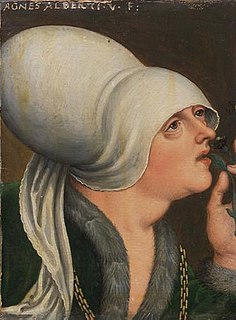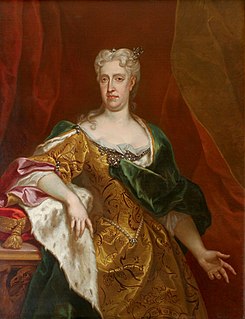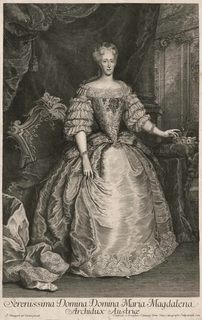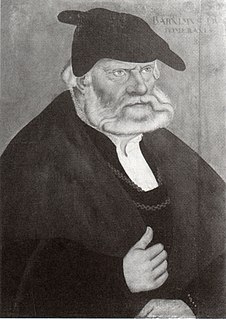Life
His family was originally from Lüneburg, and received their Bürgerrechts for Leipzig in 1490. His father was a tailor. He originally studied theology at St. Thomas School but, on the advice of Philipp Melanchthon, switched to law in 1542.
Three years later, he was working as an advisor for Chancellor Simon Pistorius [ de ] in Merseburg. In 1546, he returned to Leipzig to complete his studies. He then became Syndic for the city of Bautzen and earned his doctorate from the law faculty of Leipzig University. In 1549, he married Elisabeth Goldhan, the daughter of a merchant. Their son Christian [ de ], served as the Chancellor of Mark Brandenburg from 1588 to 1598.
Shortly after, he was appointed to the Kurfürstlicher Rat [ de ] (Electoral Council) of Joachim II Hector, Elector of Brandenburg, representing him in numerous legal matters and at the foreign embassies. In 1558, following the death of Johann Weinlob [ de ], he was named the new Chancellor. In 1569, he helped secure the transfer of the Duchy of Prussia, from King Sigismund II Augustus of Poland to Albert Frederick of the Brandenburg Hohenzollerns. As a result, he was granted a Knighthood. He was also the Lord of Mahlsdorf (now part of Berlin).
In 1895, he was chosen to be one of the historical figures represented on the Siegesallee (Victory Avenue), a monument garden in Berlin. His marble bust was created by the sculptor, Martin Wolff, and was unveiled in 1901. It was damaged during World War II, as were most of the others, and is now in storage at the Spandau Citadel.

Leopold V, Archduke of Further Austria was the son of Archduke Charles II of Inner Austria, and the younger brother of Emperor Ferdinand II, father of Ferdinand Charles, Archduke of Further Austria. He was Bishop of Passau and of Strasbourg, until he resigned to get married, and Archduke of Further Austria including Tirol.

Constance of Austria was queen of Poland as the second wife of King Sigismund III Vasa and the mother of King John II Casimir.
Count Georg Ludwig Friedrich Wilhelm zu Münster was a German paleontologist.

Paulus Melissus was a humanist Neo-Latin writer, translator and composer.

Maria Anna of Bavaria was a politically active Archduchess of Austria by marriage to Archduke Charles II of Austria. She played an important role in the counter reformation in Austria.

Anne of Bohemia and Austria was a Duchess of Luxembourg in her own right and, as a consort, Landgravine of Thuringia and of Saxony.
Henry, of the House of Ardenne–Luxembourg, was the count of Luxembourg from 998 and the duke of Bavaria from 1004. He was the son of Siegfried I of Luxembourg and Hedwige of Nordgau.

Archduchess Maria Elisabeth of Austria, was the governor of the Austrian Netherlands between 1725 and 1741.

Maria Magdalena, Archduchess of Austria was a daughter of Emperor Leopold I and his third wife Eleonore Magdalene of the Palatinate. She died unmarried.

Georg Friedrich Wilhelm Rosen was a German (Lippe/Prussian) orientalist and diplomat.

Bogislaw IV, of the House of Griffin, was Duke of Pomerania from 1278 until his death in 1309.

John Casimir, Count Palatine of Zweibrücken-Kleeburg was the son of John I, Count Palatine of Zweibrücken and his wife, Duchess Magdalene of Jülich-Cleves-Berg and was the founder of a branch of Wittelsbach Counts Palatine often called the Swedish line, because it gave rise to three subsequent kings of Sweden, but more commonly known as the Kleeburg line.

Carl Friedrich Ernst Frommann was a German publisher and bookseller.

Barnim XI, son of Bogislaw X, Duke of Pomerania, became duke on his father's death in 1523.

Matthias von Jagow was a Bishop of Brandenburg and reformer in Brandenburg.
Berthold VII, Count of Henneberg-Schleusingen was Count of Henneberg- Schleusingen from 1284 to 1340. He was the son of Count Berthold V of Henneberg-Schleusingen and his wife Sophie of Schwarzburg, the daughter of Count Günther VII of Schwarzburg. He was confirmed as Imperial Prince by Emperor Henry VI in 1310.

Anna Jagiellon, was a Polish princess member of the Jagiellonian dynasty and by marriage Duchess of Pomerania.
Peter Hafftiz was a German educator and historiographer. From 1550 he was teacher at the schools of St. Nicolai and St. Marien in Berlin, from 1560 as rector. He received Berlin citizenship in 1564. From 1577 to 1580 he was rector in the public school of Cölln.

Rudolf III von Montfort was bishop of Chur (1322–1325) and Konstanz (1322–1334). He was born into the young family of Montfort-Feldkirch of the Swabian noble family of Montfort.

Adolf I von Nassau was Bishop of Speyer 1371–1388 and Archbishop of Mainz 1381–1390.
This page is based on this
Wikipedia article Text is available under the
CC BY-SA 4.0 license; additional terms may apply.
Images, videos and audio are available under their respective licenses.

















